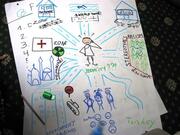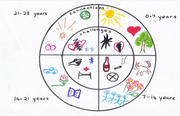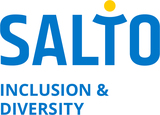Underpinning Principles: Identity, race, ethnicity, nationality
Empowerment means equality and respect, ensuring that individuals have the capacity and opportunity to equip themselves with the skills and knowledge to make informed life choices.
Identity: race, ethnicity, nationality
The concepts of race, ethnicity and nationality have, and continue to be, the subject of much debate. Despite this attention, academics, and those working in the field, have found it difficult to isolate or separate each from the other, arguing that race, ethnicity and nationality are indivisible, or interconnected, as these are what shape or make our identity, these are what make us who we are.
Race
Race has been given many different meanings through the centuries. In anthropology the term race was used to describe a geographical population of humankind that possessed inherited distinctive physical characteristics that distinguish it from other populations. It can be argued that whilst this definition could apply to a situation of geographic and cultural isolation, it could not in the transient societies that exist today.
Ethnicity
Ethnicity refers to membership of a culturally and geographically defined group that share cultural practices including but not limited to holidays, food, language, and customs, or religion. People of the same race can be of different ethnicities. Usually an ethnic group or ethnicity is a group of human beings whose members identify with each other on the basis of a presumed common genealogy or ancestry. Ethnic identity is also marked by the recognition from others of a group's distinctiveness and by common cultural, linguistic, religious, behavioural or biological traits.
Ethnicity and race are related concepts. The UNESCO Statement, signed in 1950 by some of the internationally renowned scholars of the time (including Ashley Montagu, Claude Lévi-Strauss, Gunnar Myrdal, Julian Huxley), advocated that: "National, religious, geographic, linguistic and cultural groups do not necessarily coincide with racial groups: and the cultural traits of such groups have no demonstrated genetic connection with racial traits. Because serious errors of this kind are habitually committed when the term "race" is used in popular parlance, it would be better when speaking of human races to drop the term "race" altogether and speak of 'ethnic groups'."
^^ top ^^
Nationality
Nationality refers to the country of citizenship. Nationality is sometimes used to mean ethnicity, although the two are technically different. People can share the same nationality but be of different ethnic groups and people who share an ethnic identity can be of different nationalities.
From a legal perspective international and European documents refer to these concepts in diverse ways. Many problems arise because only a few documents provide a definition of racial, ethnic and national minorities, of discrimination based on race or ethnic origin, leaving the definitions open to interpretation by the Courts.
For example: article 1 of the International Convention on the Elimination of All Forms of Racial Discrimination, adopted on 21 December 1965, states that " In this Convention, the term "racial discrimination" shall mean any distinction, exclusion, restriction or preference based on race, colour, descent, or national or ethnic origin which has the purpose or effect of nullifying or impairing the recognition, enjoyment or exercise, on an equal footing, of human rights and fundamental freedoms in the political, economic, social, cultural or any other field of public life. By contrast, the Framework Convention for the Protection of National Minorities of 1.II.1995 does not provide a definition of "national minority".
There are, then, no absolute "right" or "wrong" definitions of race and ethnicity, but there are different conceptualisations, which reflect different views. Some of these definitions are more accepted than others. However, as they are relative concepts, it is important to shape a common understanding and not assume that every person shares the same view.
Therefore, for the purpose of this publication we accept the broader concept, the indivisibility, or interconnectivity, of race, ethnicity and nationality. To recognise the myriad influences on the self is a central tenet of the empowerment process. We accept that these, and other concepts, are what shape or make our identity: are what make us who we are.
^^ top ^^
Identity: the epigenetic principle
The ego-psychologist Erik Erikson's epigenetic principle asserts that we develop through a predetermined unfolding of our personalities (or identities) in 8 stages.
Our progress through each stage is in part determined by our success, or lack of success, in all the previous stages: a kind of human metamorphosis similar to the transformational changes of a butterfly. Just as the butterfly must struggle to release itself from the cocoon then so must we struggle (or be industrious as Erikson describes) to reach our potential, to know ourselves and find our position or role within society.
Stage 1:
the first stage is approximately the first year or year and a half of life. The task is to develop trust without completely eliminating the capacity for mistrust. If the proper balance is achieved, the child will develop the virtue hope, the strong belief that, even when things are not going well, they will work out well in the end.
Stage 2:
the second stage is from about eighteen months to three or four years old. The task is to achieve a degree of autonomy while minimising shame and doubt. If parents permit the child, now a toddler, to explore and manipulate his or her environment, the child will develop a sense of autonomy or independence.
Stage 3:
from three or four to five or six, the task confronting every child is to learn initiative without too much guilt. Initiative means a positive response to the world's challenges, taking on responsibilities, learning new skills, feeling purposeful. A good balance leads to the psychosocial strength of purpose.
Stage 4:
from about six to twelve the task is to develop a capacity for industry while avoiding an excessive sense of inferiority. Children must "tame the imagination" and dedicate themselves to education and to learning the social skills their society requires of them. There is a much broader social sphere at work now: the parents and other family members are joined by teachers and peers and other members of the community at large. Children must learn that there is pleasure not only in conceiving a plan, but in carrying it out.
Stage 5:
stage five is adolescence, beginning with puberty and ending around 18 or 20 years old. The task during adolescence is to achieve ego identity and avoid role confusion. Ego identity means knowing who you are and how you fit in to the rest of society. It requires that you take all you've learned about life and yourself and mould it into a unified self-image, one that your community finds meaningful.
Stage 6:
if you have made it this far, you are in the stage of young adulthood, which lasts from about 18 to about 30. The ages in the adult stages are much fuzzier than in the childhood stages, and people may differ dramatically. The task is to achieve some degree of intimacy, as opposed to remaining in isolation. Intimacy is the ability to be close to others, as a partner, a friend, and as a participant in society.
Stage 7:
the seventh stage is that of middle adulthood. It is hard to pin a time to it, but it would include the period during which we are actively involved in raising children. For most people in our society, this would put it somewhere between the middle twenties and the late fifties. The task here is to cultivate the proper balance of generativity and stagnation. Generativity is an extension of love into the future. It is a concern for the next generation and all future generations.
Stage 8:
this last stage, referred to as late adulthood or maturity begins sometime around retirement, after the children have left home have gone, somewhere around 60. In Erikson's theory, reaching this stage is a good thing, and not reaching it suggests that earlier problems hindered your development!
Adapted from: Boeree, C, G., Personality Theories (1997)
^^ top ^^
| Stage (age) | Psychological Crisis | Significant Relations | Psychosocial Modalities | Psychosocial Virtues | Maladaptations & Malignancies |
|---|---|---|---|---|---|
|
Stage 1 (0-1) Infant |
Trust vs mistrust |
Mother |
to get, to give in return |
hope, faith |
sensory, distortion withdrawal |
|
Stage 2 (2-3) Toddler |
Autonomy vs shame and doubt |
Parents |
to hold on, to let go |
will, determination |
impulsivity |
|
Stage 3 (3-6) Preschooler |
Initiative |
Family |
to go after, to play |
purpos, courage |
ruthlessness, inhibition |
|
Stage 4 (7-12) School-Age Child |
Industry vs inferiority |
Neighbourhood and school |
to complete, to make things together |
competence |
narrow virtuosity, inertia |
|
Stage 5 (12_18) Adolescence |
Ego-identity vs role-confusion |
peer groups, role models |
to be oneself, to share oneself |
fidelity, loyalty |
fanatism, repudiation |
|
Stage 6 (the 20's) Young Adult |
Intimacy vs isolation |
partners, friends |
to lose and find oneself in another |
love |
promiscuity, exclusivity |
|
Stage 7 (late 20's to 50's) Middle Adult |
Generativity vs self-absorption |
household, workmates |
to make be, to take care of |
care |
overextension, rejectivity |
|
Stage 8 (50's and beyong) Old Adult |
Integrity vs despair |
mankind or "my kind" |
to be, through having been, to fave not being |
wisdom |
presumption, despair |
Chart adapted from: Erikson, E., (1959) Identity and the Life Cycle (Psychological Issues vol 1)
So, to understand identity is to understand the what, the why, the who.
Stage five of Erikson's epigenetic principle is a particularly important consideration when working with young ethnic minority women. Stage five is when an individual begins to identify their ego, to find and understand their place within the family, community, society.
For some this can be quite a difficult process as to achieve this the individual must understand the myriad influences that impact on their position and role.
In the next section, Intersectionality, we discuss this further and introduce you to a new tool: Google Self. Specifically developed for the TC Empower, Google Self aims to assist young ethnic minority women in their quest for self empowerment.
But first we present you with an Identity Activity to help you put that particular theory into practice!
^^ top ^^
Exercise: Mandala of IdentityAIMTo offer to participants a creative tool to help them understand the what, the why, the who. Note: This activity may be quite challenging for some participants as it is likely to raise some sensitive issues in terms of an individual's life influences. With this in mind it is important that the setting is safe and comfortable and that confidentiality is respected. Facilitators should provide space for one to one support at the end of the session. RESOURCESA3 white papers (one for each participant), newspapers, magazines, coloured pencils or pens, scissors, glue, tape. METHODOLOGYStep 1: The philosophy of the Mandala. "The basic motif is the premonition of a centre of personality, a kind of central point within the psyche, to which everything is related, by which everything is arranged and which is itself a source of energy. The energy of the central point is manifested in the almost irresistible compulsion and urge to become what one is,... this centre is not felt or thought of as the ego but, ...as the self... it is surrounded by periphery that contains everything that belongs to the self...the paired opposites that make up the total personality." Jung, C. (1959). The Mandala technique is primarily used to encourage self-reflection, with a goal of enhanced personal openness and a better understanding of the interconnection of life's influences. Step 2: Introduce the main concepts of identity as set out in the Identity section of this booklet. Step 3: Prepare a simple and uncoloured "Mandala Model" on a flipchart, drawing in it 4 quadrants entitled : The four sections have a common core at the centre of the Mandala, the common core is the self. Step 4: Ask the participants to design their own Mandala of Identity by making a collage or drawing of the influences (the people, things, places and feelings) related to the four topics mentioned above. Tip: To create a relaxed environment you could prepare some candles and soft meditation music and prepare participants with a short meditation exercise, for example: inviting them to close their eyes and go through their life, giving them some suggestions. Step 5: In groups of 4-5, ask participants to share their Mandalas. Remind participants to feel free to share what they choose and to keep some delicate parts they are not ready to share. DEBRIEFING:Ask participants to answer different questions such as: was it relaxing to complete the Mandala? Did they discover something new? Was it difficult to remain in the limitation of symmetric areas of the Mandala or did some sections need more/less space? Are there intersections, common feelings and experiences among different fields or are there separations? Exhibition:Create a space for participants who want hang their Mandalas on the wall for the other participants to see. Find this tool online in the SALTO Toolbox: click here! |
^^ top ^^
 from TC Empower
from TC Empower from TC Empower
from TC Empower
Downloads
The following downloads are available:
- E.M.power - Ethnic Minority women - 2008
Inspirational booklet on how to empower young ethnic minority women. With info for youth workers on concepts, challenges, approaches and international projects. You can do it! Based on the SALTO TC EMpower 2008.
